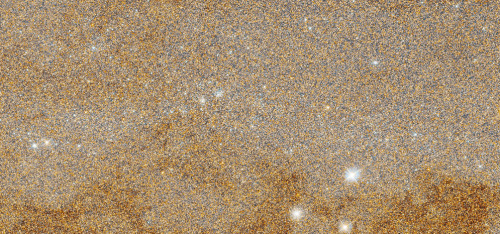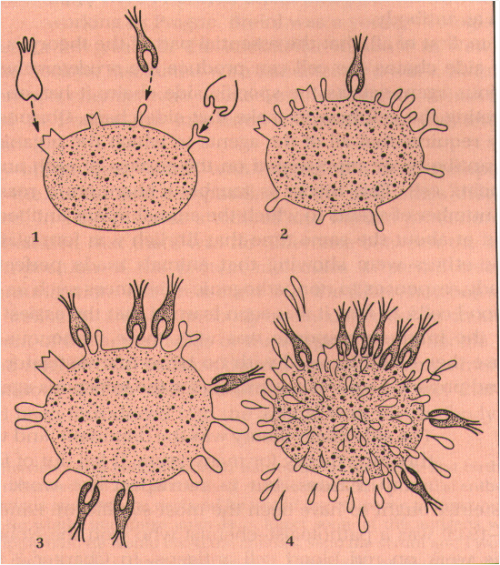Underwater Explosions Are Incredibly Dangerous And Destructive, And This Animation Shows You Why. What

Underwater explosions are incredibly dangerous and destructive, and this animation shows you why. What you see here are three balloons, each half-filled with water and half with air. A small explosive has been set off next to them in a pool. In air, the immense energy of an explosion actually doesn’t propagate all that far because much of it gets expended in compressing the air. Water, on the other hand, is incompressible, so that explosive energy just keeps propagating. For squishy, partially air-filled things like us humans or these balloons, that explosion’s force transmits into us with nearly its full effect, causing expansion and contraction of anything compressible inside us as our interior and exterior pressures try to equalize. The results can be devastating. To see the equivalent experiment in air, check out Mark Rober’s full video on how to survive a grenade blast. (Image credit: M. Rober, source)
More Posts from Study-astronomy-biology-ref and Others

Baobab & Milky Way
A baobab tree and the central band of the Milky Way galaxy in the village of Antsiraraka in Madagscar, July 2010.
Credit: Florian Breuer


Gliese 832c: is a Potentially Habitable Super-Earth Discovered only 16 Light-Years from Earth
A team of astronomers led by Dr Robert Wittenmyer of the University of New South Wales have discovered the super-Earth. The newly discovered exoplanet, labeled Gliese 832c, has an orbital period of 35.68 days, a mass 5.4 times that of Earth’s and receives about the same average energy as Earth does from the Sun. Gliese 832c might have Earth-like temperatures, giving it a similar terrestrial atmosphere. If the planet has a similar atmosphere to Earth it may be possible for life to survive, although seasonal shifts would be extrem.
Gliese 832c was discovered from its gravitational pull on its star, which causes the star to wobble slightly.









On October 8 a privileged few could see auroras in abnormally low latitudes, as the spectacular pictures above taken in Wales and Northern England.
Via TON: Northern Lights Put On Spectacular Show As Aurora Borealis Lit Skies Over Wales And Yorkshire.
Sleep is your superpower | Matt Walker
Sleep is your life-support system and Mother Nature’s best effort yet at immortality, says sleep scientist Matt Walker. In this deep dive into the science of slumber, Walker shares the wonderfully good things that happen when you get sleep – and the alarmingly bad things that happen when you don’t, for both your brain and body. Learn more about sleep’s impact on your learning, memory, immune system and even your genetic code – as well as some helpful tips for getting some shut-eye.

A shot of just a tiny bit of the Andromeda Galaxy, from the sharpest ever view taken by the Hubble Space Telescope
Full size image
MBTI Studying Tips - Part 1
DISCLAIMERS:
What I did do: Collect information and organize them into an easy-to-read-and-understand-post. What I didn’t do: Write most of it. Most of the information here isn’t my own writing, but rather useful tips I found from various sources. Credit is given at the bottom of the post.
I wrote most of this by doing a hell lot of research online and trying to ask my friends of different types irl what they thought of it. I am no professional, and my words in no way should be taken as gospel. Please, please send me corrections or your thoughts if anything I wrote was inaccurate, I will appreciate all the feedback I can get.
Hello hello! Your old friend Skye is here with some tips for studying based on your MBTI personality type. Now before we jump straight into things, let’s answer a few basic questions:
What is MBTI?
MBTI stands for the Myers-Briggs Type Indicator, which is basically a personality test that classifies you into one of 16 different personality categories based on a four-letter code. This is what the “INFP” or “ESFJ” codes mean if you’ve been seeing them around in the community. The test assesses you on four of your main traits:
How do you prefer to direct your energy? (I vs E)
What kind of information do you prefer to gather? (S vs N)
What criteria do you prefer for making decisions? (T vs F)
What kind of environment do you prefer? (J vs P)
So how do I find out what’s my type?
You can take a free online quiz here!
Okay, but what’s with the ‘Introverted Thinking’ and ‘Fi’ and all the fancy terms?
You can read more about Cognitive Function Theory here! I will be basing my post off this theory because I think it’s a more comprehensive method of understanding MBTI.
Onwards! (The rest is under the cut bc skye rambled and it’s long af even tho I’m just covering the introverted functions)
Keep reading

Antibodies are the secreted form of B-lymphocyte receptors and are a part of adaptive immunity, but how are these proteins formed?
Above is a diagram illustrating Paul Ehlrich’s Side Chain Theory of Antibody Formation. Ehlrich proposed that immunoglobulin molecules, a fundamental component of adaptive immunity, served as membrane bound proteins that bound to particular threats, similarly to the former “key in lock” view of enzymes in catalyzing biological reactions. Ehrlich also suggested that the action of binding a pathogenic molecule to the receptor would generate a signal to stimulate the production of more receptors of the same specificity. These “side chains” that were added on would then break off from the cell surface and become what we call antibodies.
We now know, however, that soluble immunoglobulin receptors are specially manufactured to be secreted as antibody, rather than just “breaking off” of the lymphocyte, even though they have the same specificity as their membrane-bound counterparts.
-
 lurker-at-thresholds reblogged this · 1 year ago
lurker-at-thresholds reblogged this · 1 year ago -
 lurker-at-thresholds liked this · 1 year ago
lurker-at-thresholds liked this · 1 year ago -
 ericaguilart liked this · 4 years ago
ericaguilart liked this · 4 years ago -
 isisishtar-archived liked this · 4 years ago
isisishtar-archived liked this · 4 years ago -
 techjum reblogged this · 4 years ago
techjum reblogged this · 4 years ago -
 dubiousspectrum reblogged this · 5 years ago
dubiousspectrum reblogged this · 5 years ago -
 theinquisitivereceptacle reblogged this · 6 years ago
theinquisitivereceptacle reblogged this · 6 years ago -
 alistairnoxa liked this · 6 years ago
alistairnoxa liked this · 6 years ago -
 singingstatic liked this · 6 years ago
singingstatic liked this · 6 years ago -
 risureference reblogged this · 7 years ago
risureference reblogged this · 7 years ago -
 ceceropia liked this · 7 years ago
ceceropia liked this · 7 years ago -
 snagglefangswordsman liked this · 7 years ago
snagglefangswordsman liked this · 7 years ago -
 mikatosis-blog liked this · 7 years ago
mikatosis-blog liked this · 7 years ago -
 rememberthisdude reblogged this · 7 years ago
rememberthisdude reblogged this · 7 years ago -
 wattenmelon reblogged this · 7 years ago
wattenmelon reblogged this · 7 years ago -
 farfromhomehannah liked this · 7 years ago
farfromhomehannah liked this · 7 years ago -
 eldritch-horror56 liked this · 7 years ago
eldritch-horror56 liked this · 7 years ago -
 pikiserra liked this · 8 years ago
pikiserra liked this · 8 years ago -
 logicandfeels liked this · 8 years ago
logicandfeels liked this · 8 years ago -
 lilbit253 liked this · 8 years ago
lilbit253 liked this · 8 years ago -
 bijoumikhawal liked this · 8 years ago
bijoumikhawal liked this · 8 years ago -
 monibymoni liked this · 8 years ago
monibymoni liked this · 8 years ago -
 theplacefulloflight liked this · 8 years ago
theplacefulloflight liked this · 8 years ago -
 fluffy-kitten404 liked this · 8 years ago
fluffy-kitten404 liked this · 8 years ago -
 blapis-blazuli liked this · 8 years ago
blapis-blazuli liked this · 8 years ago -
 captainblucifer liked this · 8 years ago
captainblucifer liked this · 8 years ago -
 arcademarmalade reblogged this · 8 years ago
arcademarmalade reblogged this · 8 years ago -
 starrystims-blog liked this · 8 years ago
starrystims-blog liked this · 8 years ago -
 number1elfenthusiast reblogged this · 8 years ago
number1elfenthusiast reblogged this · 8 years ago -
 number1elfenthusiast liked this · 8 years ago
number1elfenthusiast liked this · 8 years ago

This is a studyblr for everyone have some passion for science, especially astronomy and biology
129 posts


